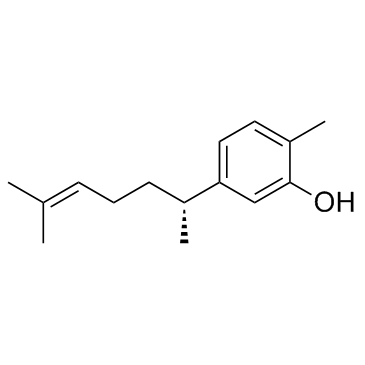30199-26-9
| Name | 2-methyl-5-[(2R)-6-methylhept-5-en-2-yl]phenol |
|---|---|
| Synonyms |
2-Methyl-5-[(2R)-6-methyl-5-hepten-2-yl]phenol
2-Methyl-5-[(2R)-6-methylhept-5-en-2-yl]phenol 1,3,5,10-bisabolatetraen-3-ol Phenol,5-(1,5-dimethyl-4-hexenyl)-2-methyl-,(-) (R)-xanthorrhizol (-)-5-(1,5-Dimethyl-4-hexenyl)-2-methylphenol (R)-5-(1,5-Dimethyl-4-hexenyl)-o-cresol xanthorrhizol (R)-5-(1-5-Dimethyl-4-hexenyl)-2-methylphenol Xanthorrizol Phenol, 5-(1,5-dimethyl-4-hexenyl)-2-methyl-, (R)- (R)-(-)-xanthorrizol Phenol, 5-[(1R)-1,5-dimethyl-4-hexenyl]-2-methyl- Phenol, 5-[(1R)-1,5-dimethyl-4-hexen-1-yl]-2-methyl- (1R)-5-(1,5-dimethyl-4-hexenyl)-2-methylphenol EINECS 250-090-2 |
| Description | Xanthorrhizol, isolated from Curcuma xanthorrhiza Roxb, is a potential antibacterial agent. |
|---|---|
| Related Catalog | |
| In Vitro | Xanthorrhizol is a potential antibacterial agent from Curcuma xanthorrhiza against streptocpccus mutants[1]. SEM analysis shows that, treatment of Candida species with MIC of Xanthorrhizol affects the external morphology of these yeasts. Cells incubated in the presence of Xanthorrhizol demonstrate a greater tendency to clump compared with the control cultures. Xanthorrhizol treated C. glabrata cells shows minor abnormalities without a smooth or a slightly awkward surface. Xanthorrhizol-treated Candida cells exhibit deformation and protrusions on the cell surface, which is more clearly demonstrated with C. guilliermondii and C. parapsilosis. In general, Candida exposed to, Xanthorrhizol at concentrations 1 x MICs exhibits substantial ultrastructural abnormalities such as shape deformation, protrusion, rugged cells surface, and clumping[2]. |
| In Vivo | Ear edema induced by the topical application of TPA is suppressed by pre-treatment with Xanthorrhizol in a doserelated manner (P<0.005). Topical application of Xanthorrhizol alone does not induce ear edema in mice. All the mice treated with 7.5 nM TPA for 19 weeks after initiation by DMBA developed an average of 15.5±2.3 skin tumors per mouse (tumor multiplicity). Pre-treatment with 2 and 6 μM Xanthorrhizol reduces tumor multiplicity to 6.9±1.1 (P<0.005) and 4.0±1.1 (P<0.005), respectively, at 19 weeks. In addition, Xanthorrhizol at 2 and 6 μM dose dependently lowers the percentage of tumor-bearing mice (tumor incidence) to 80 and 57%, respectively, at the termination of the experiments. Furthermore, the tumor multiplicity (P<0.05) and incidence are reduced in the DMBA-initiated mice that are topically treated with Xanthorrhizol for 6 weeks after the induction of papillomas with hyperplasia, mild dysplasia and moderate dysplasia by topical TPA application for 6, 18 and 24 weeks, respectively. The increased ODC expression in mouse epidermis with acute inflammation and tumor promotion induced by TPA is inhibited by pre-treatment with Xanthorrhizol in a dose-dependent manner. The topical application of Xanthorrhizol after the induction of papillomas with hyperplasia and dysplasia also potently inhibited ODC expression[3]. |
| References |
| Density | 0.9±0.1 g/cm3 |
|---|---|
| Boiling Point | 326.9±11.0 °C at 760 mmHg |
| Molecular Formula | C15H22O |
| Molecular Weight | 218.335 |
| Flash Point | 147.2±8.9 °C |
| Exact Mass | 218.167068 |
| PSA | 20.23000 |
| LogP | 5.48 |
| Vapour Pressure | 0.0±0.7 mmHg at 25°C |
| Index of Refraction | 1.522 |
| Hazard Codes | T |
|---|---|
| Risk Phrases | R60 |
| Safety Phrases | S45;S53;S36/S37/S39 |


